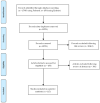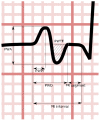Electrocardiographic Predictors of Atrial Fibrillation
- PMID: 37092499
- PMCID: PMC10123668
- DOI: 10.3390/medsci11020030
Electrocardiographic Predictors of Atrial Fibrillation
Abstract
Background: Atrial fibrillation (AF) is the most common pathological arrhythmia, and its complications lead to significant morbidity and mortality. However, patients with AF can often go undetected, especially if they are asymptomatic or have a low burden of paroxysms. Identification of those at high risk of AF development may help refine screening and management strategies.
Methods: PubMed and Embase databases were systematically searched for studies looking at electrocardiographic predictors of AF from inception to August 2021.
Results: A total of 115 studies were reported which examined a combination of atrial and ventricular parameters that could be electrocardiographic predictors of AF. Atrial predictors include conduction parameters, such as the PR interval, p-wave index and dispersion, and partial interatrial or advanced interatrial block, or morphological parameters, such as p-wave axis, amplitude and terminal force. Ventricular predictors include abnormalities in QRS amplitude, morphology or duration, QT interval duration, r-wave progression and ST segment, i.e., t-wave abnormalities.
Conclusions: There has been significant interest in electrocardiographic prediction of AF, especially in populations at high risk of atrial AF, such as those with an embolic stroke of undetermined source. This review highlights the breadth of possible predictive parameters, and possible pathological bases for the predictive role of each parameter are proposed.
Keywords: atrial fibrillation; atrial parameters; prediction; ventricular parameters.
Conflict of interest statement
The authors declare no conflict of interest.
Figures




Similar articles
-
Intravenous magnesium sulphate and sotalol for prevention of atrial fibrillation after coronary artery bypass surgery: a systematic review and economic evaluation.Health Technol Assess. 2008 Jun;12(28):iii-iv, ix-95. doi: 10.3310/hta12280. Health Technol Assess. 2008. PMID: 18547499
-
Curative catheter ablation in atrial fibrillation and typical atrial flutter: systematic review and economic evaluation.Health Technol Assess. 2008 Nov;12(34):iii-iv, xi-xiii, 1-198. doi: 10.3310/hta12340. Health Technol Assess. 2008. PMID: 19036232
-
Systematic screening for the detection of atrial fibrillation.Cochrane Database Syst Rev. 2016 Jun 3;2016(6):CD009586. doi: 10.1002/14651858.CD009586.pub3. Cochrane Database Syst Rev. 2016. PMID: 27258214 Free PMC article.
-
Systematic review and cost-effectiveness evaluation of 'pill-in-the-pocket' strategy for paroxysmal atrial fibrillation compared to episodic in-hospital treatment or continuous antiarrhythmic drug therapy.Health Technol Assess. 2010 Jun;14(31):iii-iv, 1-75. doi: 10.3310/hta14310. Health Technol Assess. 2010. PMID: 20569652
-
Signs and symptoms to determine if a patient presenting in primary care or hospital outpatient settings has COVID-19.Cochrane Database Syst Rev. 2022 May 20;5(5):CD013665. doi: 10.1002/14651858.CD013665.pub3. Cochrane Database Syst Rev. 2022. PMID: 35593186 Free PMC article.
Cited by
-
Post-Liver Transplantation Atrial Fibrillation: Insights into Clinical and ECG Predictors.Ann Transplant. 2025 May 13;30:e948243. doi: 10.12659/AOT.948243. Ann Transplant. 2025. PMID: 40356224 Free PMC article.
-
The Electroanatomic Volume of the Left Atrium as a Determinant of Recurrences in Patients with Atrial Fibrillation After Pulmonary Vein Isolation: A Prospective Study.Biomedicines. 2024 Dec 24;13(1):7. doi: 10.3390/biomedicines13010007. Biomedicines. 2024. PMID: 39857590 Free PMC article.
-
The Effect of Obesity on Repolarization and Other ECG Parameters.J Clin Med. 2024 Jun 19;13(12):3587. doi: 10.3390/jcm13123587. J Clin Med. 2024. PMID: 38930116 Free PMC article.
-
Cardiorenal Interorgan Assessment via a Novel Clustering Method Using Dynamic Time Warping on Electrocardiogram: Model Development and Validation Study.JMIR Med Inform. 2025 Aug 12;13:e73353. doi: 10.2196/73353. JMIR Med Inform. 2025. PMID: 40795375 Free PMC article.
-
The incidence of atrial fibrillation detected by implantable loop recorders: a comparison between patients with and without embolic stroke of undetermined source.Eur Heart J Open. 2024 Sep 1;4(5):oeae061. doi: 10.1093/ehjopen/oeae061. eCollection 2024 Sep. Eur Heart J Open. 2024. PMID: 39219854 Free PMC article.
References
-
- Hindricks G., Potpara T., Dagres N., Arbelo E., Bax J.J., Blomström-Lundqvist C., Boriani G., Castella M., Dan G.-A., Dilaveris P.E., et al. 2020 ESC Guidelines for the diagnosis and management of atrial fibrillation developed in collaboration with the European Association of Cardio-Thoracic Surgery (EACTS) Eur. Heart J. 2020;42:373–498. doi: 10.1093/eurheartj/ehaa612. - DOI - PubMed
-
- Krijthe B.P., Kunst A., Benjamin E.J., Lip G.Y.H., Franco O.H., Hofman A., Witteman J., Stricker B.H., Heeringa J. Projections on the number of individuals with atrial fibrillation in the European Union, from 2000 to 2060. Eur. Heart J. 2013;34:2746–2751. doi: 10.1093/eurheartj/eht280. - DOI - PMC - PubMed
-
- Benjamin E.J., Muntner P., Alonso A., Bittencourt M.S., Callaway C.W., Carson A.P., Chamberlain A.M., Chang A.R., Cheng S., Das S.R., et al. Heart Disease and Stroke Statistics-2019 Update: A Report from the American Heart Association. Circulation. 2019;139:e56–e528. doi: 10.1161/CIR.0000000000000659. - DOI - PubMed
Publication types
MeSH terms
LinkOut - more resources
Full Text Sources
Medical
Research Materials

